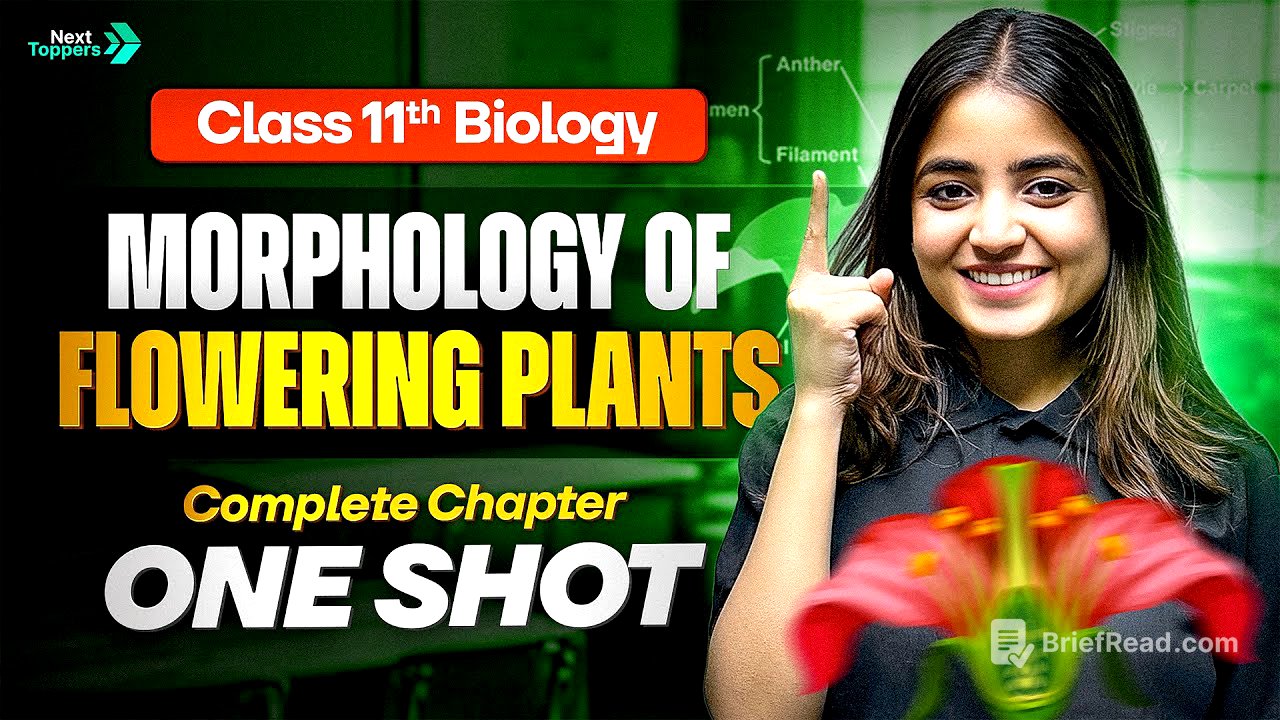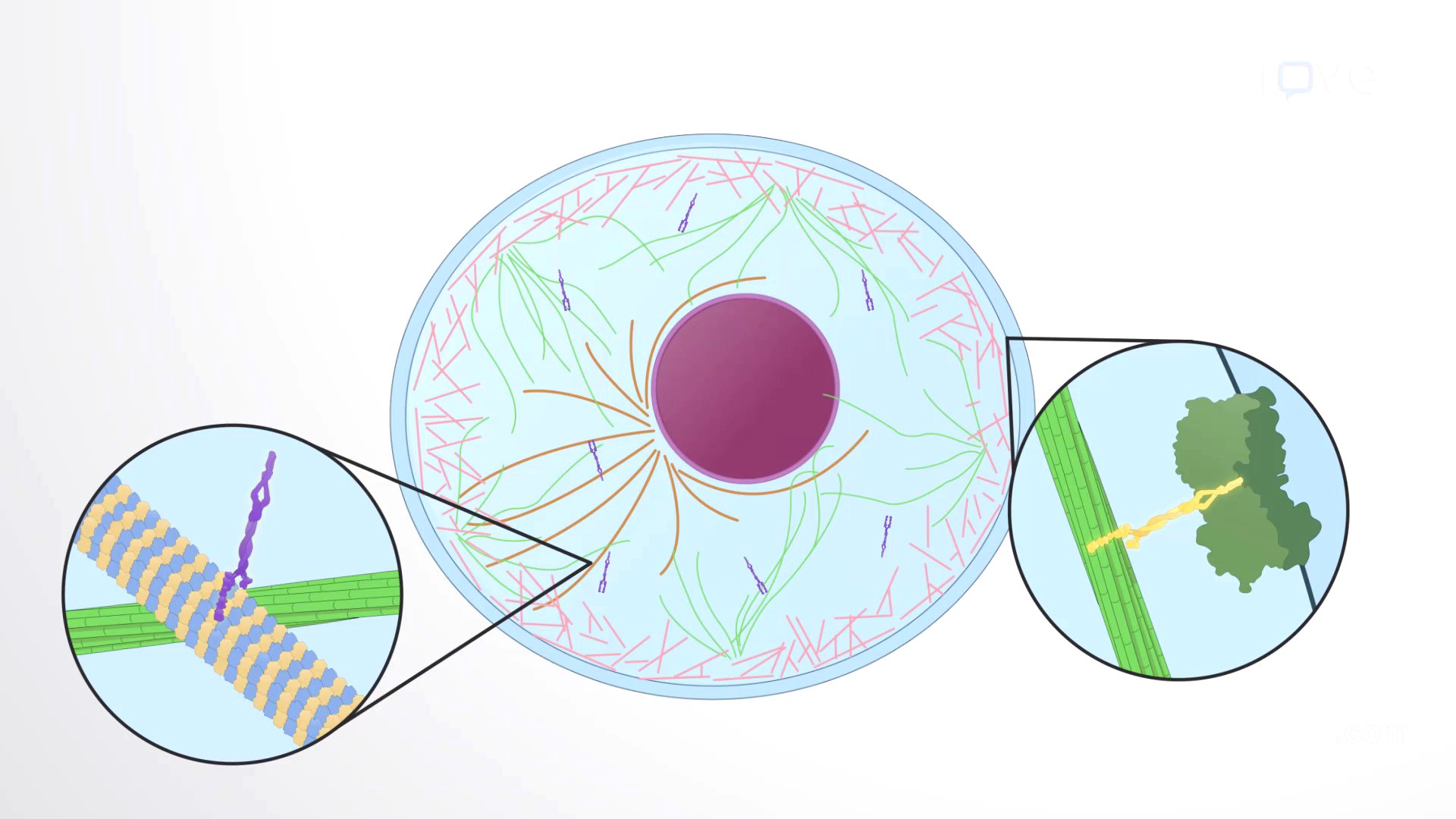TLDR;
This video provides a detailed explanation of Chapter Five, "Morphology of Flowering Plants," for 11th-grade science students. The lecture covers roots, stems, leaves, inflorescence, flowers, fruits, and seeds, including their types, characteristics, and functions. It emphasizes the importance of understanding terminology and remembering examples for exam preparation.
- Morphology of Flowering Plants overview
- Detailed explanation of roots, stems, leaves, inflorescence, flowers, fruits and seeds
- Focus on terminology and examples
Introduction [0:00]
The video introduces Chapter Five, "Morphology of Flowering Plants," for Class 11th, emphasizing the importance of understanding the meaning of the chapter's name. Morphology refers to the external structures of flowering plants, also known as angiosperms. The chapter will cover external features and structures such as roots, stems, leaves, and fruits.
Root: Development and General Characteristics [1:23]
The discussion begins with the root, explaining that it develops from the radical. General characteristics of roots include their cylindrical shape, non-green color, and underground location. Roots lack nodes and internodes, which are present in stems. Nodes are points where leaves originate, and internodes are the distances between two nodes. Lateral branching is visible in roots, forming primary, secondary, and tertiary roots. Roots are positively geotrophic, growing towards gravity, positively hydrotrophic, growing towards water, and negatively phototrophic, growing away from sunlight.
Types of Root Systems [6:29]
There are three types of root systems: tap root, fibrous root, and adventitious root. The tap root system develops from the radical, forming a primary root with further lateral branching into secondary and tertiary roots; an example is the mustard plant. The fibrous root system features a short-lived primary root replaced by fiber-like roots, common in monocots like the wheat plant. Adventitious roots develop from plant parts other than the radical, such as stems, and are exemplified by the banyan tree.
Functions of the Root [12:12]
The primary function of the root is the absorption of water and minerals. Roots also provide anchorage, keeping the plant in place by binding the soil. Additionally, some roots serve as storage for reserve food material and synthesize plant growth regulators like auxin.
Regions of the Root [13:36]
The root has three main regions: the region of meristematic activity, the region of elongation, and the region of maturation, along with the root cap. The root cap, a living, thimble-shaped structure, protects the meristematic activity. The region of meristematic activity contains small, compactly arranged, dividing cells with thin cell walls and prominent nuclei, lacking intercellular space and vacuoles. The region of elongation features elongated cells responsible for the root's growth in length, with maximum active absorption of water and minerals. The region of maturation is where cells differentiate and mature, forming fine, thread-like root hairs, extensions of epidermal cells, for passive absorption of water, increasing the surface area for absorption.
Stem: General Characteristics and Bud [24:48]
The stem bears branches, flowers, and fruits, and is initially green, turning woody and dark brown later. Stems have nodes and internodes and develop from the plumule. A bud is a compressed shoot, with two types: axillary/lateral buds, located between the leaf and stem, and terminal/apical buds, located at the tip. Stems are positively phototrophic, growing towards sunlight, and negatively geotrophic, growing away from gravity.
Functions of the Stem [28:34]
The main functions of the stem include spreading out branches, bearing leaves, flowers, and fruits, conducting water and minerals, storage, support, protection, and vegetative propagation.
Leaf: Structure and Parts [29:39]
A leaf is a lateral, flattened, and photosynthetic structure. Its parts include the leaf base, petiole, and lamina (leaf blade). The petiole is a flexible stalk that allows the leaf to flutter in the wind and provides proper sunlight. The leaf base sometimes partially or wholly covers the stem and can be swollen, forming a pulvinus. The lamina is the green, expanded part with veins and veinlets, the midrib providing rigidity and acting as a channel for transport.
Venation: Types and Examples [37:07]
Venation is the arrangement of veins and veinlets on a leaf, categorized into reticulate and parallel types. Reticulate venation forms a network, common in dicotyledonous plants, while parallel venation features parallelly arranged veins, typical in monocotyledons like banana leaves.
Types of Leaves: Simple vs. Compound [39:36]
Leaves are classified as simple or compound. A simple leaf has an entire lamina, and if incised, the incisions do not touch the midrib. A compound leaf has incisions that reach the midrib, forming leaflets. Compound leaves are further divided into pinnately compound, where leaflets are arranged along a common axis (rachis), as in neem, and palmately compound, where leaflets attach at a common point at the tip of the petiole, as in silk cotton.
Phyllotaxy: Arrangement of Leaves [45:04]
Phyllotaxy is the arrangement of leaves on the stem and branches, with three types: alternate, opposite, and whorled. Alternate phyllotaxy has one leaf arising from each node, as seen in China rose, mustard, and sunflower. Opposite phyllotaxy has two leaves arising from one node, as in Calotropis and guava. Whorled phyllotaxy has several leaves arising from a single node, as in Alstonia.
Inflorescence: Types and Arrangement [48:10]
Inflorescence refers to the arrangement of flowers on the floral axis. There are two main types: racemose and cymose. In racemose inflorescence, the youngest flowers are at the top, and the oldest are at the base, with unlimited growth. In cymose inflorescence, the youngest flowers are at the base, and the oldest are at the top, with limited growth.
Flower: Structure and Components [51:53]
A flower develops from the shoot apical meristem, which transforms into the floral meristem. The flower consists of a pedicel (stock), thalamus, sepals (calyx), petals (corolla), stamen (androecium), and pistil/carpel (gynoecium). The calyx protects the flower in the bud stage, and the corolla attracts pollinating agents. The androecium is the male reproductive organ, and the gynoecium is the female reproductive organ.
Flower: Complete vs. Incomplete, Symmetry, and Floral Appendages [57:41]
A complete flower has all four walls (calyx, corolla, androecium, and gynoecium), while an incomplete flower lacks one or more walls. If the calyx and corolla are fused, it is called a perianth. Flowers can be bisexual (both androecium and gynoecium present) or unisexual (only one present). Based on symmetry, flowers are actinomorphic (radial symmetry), zygomorphic (bilateral symmetry), or asymmetric (no symmetry). Floral appendages can be trimerous (multiples of three), tetramerous (multiples of four), or pentamerous (multiples of five).
Flower: Bracts and Ovary Position [1:05:50]
A bracteate flower has a small leaf-like structure (bract) at the base of the pedicel, while an ebracteate flower lacks it. Based on the position of the ovary, flowers are hypogynous (superior ovary), perigynous (half inferior ovary), or epigynous (inferior ovary). Examples include mustard, China rose, and brinjal for hypogynous; plum, peach, and rose for perigynous; and guava, cucumber, and ray florets of sunflower for epigynous.
Flower: Calyx and Corolla [1:10:37]
The calyx is the outermost wall, composed of sepals, which can be free (polysepalous) or fused (gamosepalous). The corolla is composed of petals, which can be free (polypetalous) or fused (gamopetalous).
Estivation: Arrangement of Calyx and Corolla [1:12:19]
Estivation is the arrangement of calyx and corolla in the floral bud, with types including valvate (sepals or petals touching each other), twisted (one margin overlapping the next), imbricate (margins overlapping but not in a particular direction), and vexillary (five petals with one standard, two wings, and two keels). Examples include Calotropis for valvate, China rose for twisted, Cassia and cotton for imbricate, and pea and bean for vexillary.
Androecium: Structure and Variations [1:17:18]
The androecium is the male reproductive structure, composed of stamens, each with a filament and anther. The anther is typically bilobed and tetrasporangiate, containing microsporangia where pollen grains are formed. The length of the filament varies, leading to tetradynamous (four long, two short stamens) and didynamous (two long, two short stamens) conditions. A staminode is a sterile stamen.
Androecium: Cohesion and Adhesion [1:22:20]
Stamens can be fused with themselves (cohesion) or with other floral parts (adhesion). Cohesion includes monadelphous (filaments fused into one bundle), diadelphous (filaments fused into two bundles), and polyadelphous (filaments fused into multiple bundles). Adhesion includes epipetalous (stamens fused to petals) and epiphyllous (stamens fused to perianth).
Gynoecium: Structure and Types [1:27:03]
The gynoecium is the female reproductive structure, composed of pistils/carpels, each with a stigma, style, and ovary. The ovary contains ovules attached to the placenta. A flower can be monocarpellary (one pistil) or multicarpellary (multiple pistils). Multicarpellary gynoecia can be syncarpous (carpels fused) or apocarpous (carpels free).
Placentation: Arrangement of Ovules [1:30:27]
Placentation is the arrangement of ovules on the placenta, with five types: marginal (ovules on a ridge along the ventral suture), axile (ovules attached to a central axis in a multilocular ovary), parietal (ovules on the inner wall of the ovary), free central (ovules on a central axis without septa), and basal (placenta at the base of the ovary with a single ovule).
Fruit: Development and Structure [1:37:19]
A fruit is a ripened ovary, and if formed without fertilization, it is called a parthenocarpic fruit. The fruit wall (pericarp) has three layers: epicarp (outer), mesocarp (middle), and endocarp (inner). A drupe is a simple, fleshy fruit with a stony endocarp, such as mango and coconut.
Seed: Structure and Types [1:39:26]
A seed is a ripened ovule, with a seed coat consisting of an outer testa and an inner tegmen. There are two types of seeds: dicot (two cotyledons) and monocot (one cotyledon). Dicot seeds have an embryonal axis with a plumule (future shoot) and radicle (future root), and the portion above the cotyledons is the epicotyl, while the portion below is the hypocotyl. Seeds can be endospermous (endosperm present) or non-endospermous (endosperm absent).
Seed: Monocot Structure [1:43:21]
Monocot seeds have one cotyledon called the scutellum, an aleurone layer (proteinaceous layer), and an endosperm. The plumule is protected by the coleoptile, and the radicle is protected by the coleorhiza. Orchids are an exception, being non-endospermous.
Technical Description of a Flowering Plant: Floral Formula and Diagram [1:44:59]
The technical description includes the floral formula and floral diagram. The floral formula uses symbols to represent the flower's characteristics, such as ♂ (male), ♀ (female), ⚥ (bisexual), Br (bracteate), K (calyx), C (corolla), A (androecium), and G (gynoecium). The position of the ovary is indicated by a line below (superior) or above (inferior) the G. Actinomorphic and zygomorphic symmetries also have specific symbols. The floral diagram provides a visual representation of the flower's structure.
Floral Formula and Diagram: Examples and Floral Characters [1:47:30]
The floral formula and diagram are used to describe specific plants, such as mustard and Solanum. The floral characters, including inflorescence, flower type, calyx, corolla, androecium, and gynoecium, are used to construct the floral formula and diagram.
Questions and Conclusion [1:51:30]
The video concludes with a series of questions to test understanding of the material, covering topics such as zygomorphic flowers, matching lists of floral characteristics, and identifying floral diagrams. The lecture emphasizes the importance of remembering examples and understanding terminology for exam preparation.









